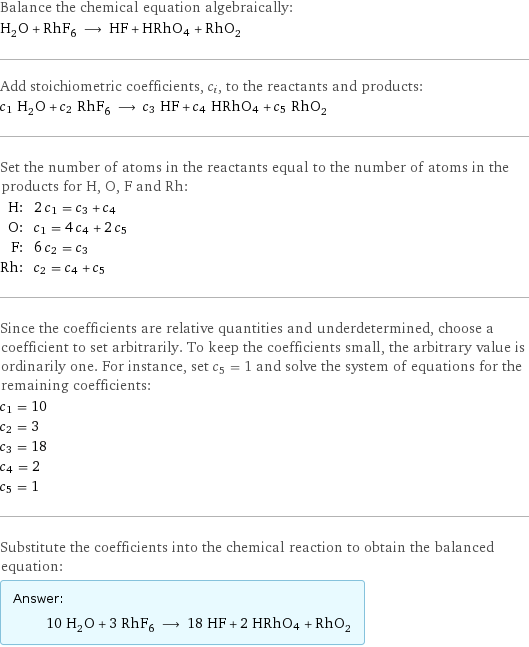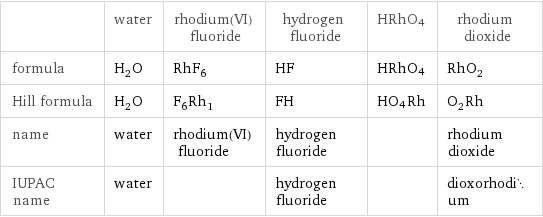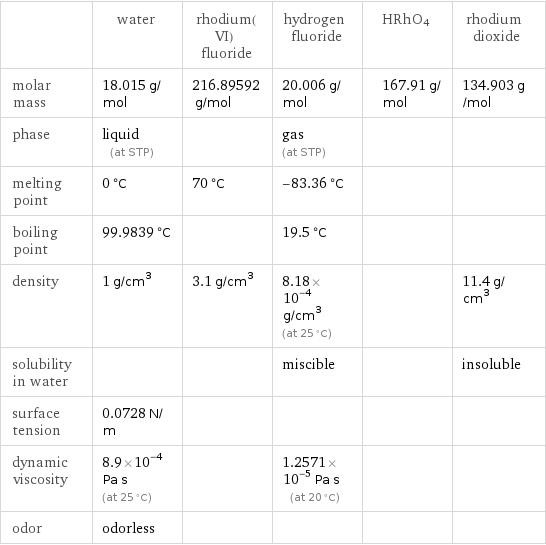Input interpretation

H_2O water + RhF_6 rhodium(VI) fluoride ⟶ HF hydrogen fluoride + HRhO4 + RhO_2 rhodium dioxide
Balanced equation

Balance the chemical equation algebraically: H_2O + RhF_6 ⟶ HF + HRhO4 + RhO_2 Add stoichiometric coefficients, c_i, to the reactants and products: c_1 H_2O + c_2 RhF_6 ⟶ c_3 HF + c_4 HRhO4 + c_5 RhO_2 Set the number of atoms in the reactants equal to the number of atoms in the products for H, O, F and Rh: H: | 2 c_1 = c_3 + c_4 O: | c_1 = 4 c_4 + 2 c_5 F: | 6 c_2 = c_3 Rh: | c_2 = c_4 + c_5 Since the coefficients are relative quantities and underdetermined, choose a coefficient to set arbitrarily. To keep the coefficients small, the arbitrary value is ordinarily one. For instance, set c_5 = 1 and solve the system of equations for the remaining coefficients: c_1 = 10 c_2 = 3 c_3 = 18 c_4 = 2 c_5 = 1 Substitute the coefficients into the chemical reaction to obtain the balanced equation: Answer: | | 10 H_2O + 3 RhF_6 ⟶ 18 HF + 2 HRhO4 + RhO_2
Structures

+ ⟶ + HRhO4 +
Names

water + rhodium(VI) fluoride ⟶ hydrogen fluoride + HRhO4 + rhodium dioxide
Equilibrium constant
![Construct the equilibrium constant, K, expression for: H_2O + RhF_6 ⟶ HF + HRhO4 + RhO_2 Plan: • Balance the chemical equation. • Determine the stoichiometric numbers. • Assemble the activity expression for each chemical species. • Use the activity expressions to build the equilibrium constant expression. Write the balanced chemical equation: 10 H_2O + 3 RhF_6 ⟶ 18 HF + 2 HRhO4 + RhO_2 Assign stoichiometric numbers, ν_i, using the stoichiometric coefficients, c_i, from the balanced chemical equation in the following manner: ν_i = -c_i for reactants and ν_i = c_i for products: chemical species | c_i | ν_i H_2O | 10 | -10 RhF_6 | 3 | -3 HF | 18 | 18 HRhO4 | 2 | 2 RhO_2 | 1 | 1 Assemble the activity expressions accounting for the state of matter and ν_i: chemical species | c_i | ν_i | activity expression H_2O | 10 | -10 | ([H2O])^(-10) RhF_6 | 3 | -3 | ([RhF6])^(-3) HF | 18 | 18 | ([HF])^18 HRhO4 | 2 | 2 | ([HRhO4])^2 RhO_2 | 1 | 1 | [RhO2] The equilibrium constant symbol in the concentration basis is: K_c Mulitply the activity expressions to arrive at the K_c expression: Answer: | | K_c = ([H2O])^(-10) ([RhF6])^(-3) ([HF])^18 ([HRhO4])^2 [RhO2] = (([HF])^18 ([HRhO4])^2 [RhO2])/(([H2O])^10 ([RhF6])^3)](../image_source/972341232996d3fd667e486af454f8f1.png)
Construct the equilibrium constant, K, expression for: H_2O + RhF_6 ⟶ HF + HRhO4 + RhO_2 Plan: • Balance the chemical equation. • Determine the stoichiometric numbers. • Assemble the activity expression for each chemical species. • Use the activity expressions to build the equilibrium constant expression. Write the balanced chemical equation: 10 H_2O + 3 RhF_6 ⟶ 18 HF + 2 HRhO4 + RhO_2 Assign stoichiometric numbers, ν_i, using the stoichiometric coefficients, c_i, from the balanced chemical equation in the following manner: ν_i = -c_i for reactants and ν_i = c_i for products: chemical species | c_i | ν_i H_2O | 10 | -10 RhF_6 | 3 | -3 HF | 18 | 18 HRhO4 | 2 | 2 RhO_2 | 1 | 1 Assemble the activity expressions accounting for the state of matter and ν_i: chemical species | c_i | ν_i | activity expression H_2O | 10 | -10 | ([H2O])^(-10) RhF_6 | 3 | -3 | ([RhF6])^(-3) HF | 18 | 18 | ([HF])^18 HRhO4 | 2 | 2 | ([HRhO4])^2 RhO_2 | 1 | 1 | [RhO2] The equilibrium constant symbol in the concentration basis is: K_c Mulitply the activity expressions to arrive at the K_c expression: Answer: | | K_c = ([H2O])^(-10) ([RhF6])^(-3) ([HF])^18 ([HRhO4])^2 [RhO2] = (([HF])^18 ([HRhO4])^2 [RhO2])/(([H2O])^10 ([RhF6])^3)
Rate of reaction
![Construct the rate of reaction expression for: H_2O + RhF_6 ⟶ HF + HRhO4 + RhO_2 Plan: • Balance the chemical equation. • Determine the stoichiometric numbers. • Assemble the rate term for each chemical species. • Write the rate of reaction expression. Write the balanced chemical equation: 10 H_2O + 3 RhF_6 ⟶ 18 HF + 2 HRhO4 + RhO_2 Assign stoichiometric numbers, ν_i, using the stoichiometric coefficients, c_i, from the balanced chemical equation in the following manner: ν_i = -c_i for reactants and ν_i = c_i for products: chemical species | c_i | ν_i H_2O | 10 | -10 RhF_6 | 3 | -3 HF | 18 | 18 HRhO4 | 2 | 2 RhO_2 | 1 | 1 The rate term for each chemical species, B_i, is 1/ν_i(Δ[B_i])/(Δt) where [B_i] is the amount concentration and t is time: chemical species | c_i | ν_i | rate term H_2O | 10 | -10 | -1/10 (Δ[H2O])/(Δt) RhF_6 | 3 | -3 | -1/3 (Δ[RhF6])/(Δt) HF | 18 | 18 | 1/18 (Δ[HF])/(Δt) HRhO4 | 2 | 2 | 1/2 (Δ[HRhO4])/(Δt) RhO_2 | 1 | 1 | (Δ[RhO2])/(Δt) (for infinitesimal rate of change, replace Δ with d) Set the rate terms equal to each other to arrive at the rate expression: Answer: | | rate = -1/10 (Δ[H2O])/(Δt) = -1/3 (Δ[RhF6])/(Δt) = 1/18 (Δ[HF])/(Δt) = 1/2 (Δ[HRhO4])/(Δt) = (Δ[RhO2])/(Δt) (assuming constant volume and no accumulation of intermediates or side products)](../image_source/b8b916b8c06182972429c755dcb02f78.png)
Construct the rate of reaction expression for: H_2O + RhF_6 ⟶ HF + HRhO4 + RhO_2 Plan: • Balance the chemical equation. • Determine the stoichiometric numbers. • Assemble the rate term for each chemical species. • Write the rate of reaction expression. Write the balanced chemical equation: 10 H_2O + 3 RhF_6 ⟶ 18 HF + 2 HRhO4 + RhO_2 Assign stoichiometric numbers, ν_i, using the stoichiometric coefficients, c_i, from the balanced chemical equation in the following manner: ν_i = -c_i for reactants and ν_i = c_i for products: chemical species | c_i | ν_i H_2O | 10 | -10 RhF_6 | 3 | -3 HF | 18 | 18 HRhO4 | 2 | 2 RhO_2 | 1 | 1 The rate term for each chemical species, B_i, is 1/ν_i(Δ[B_i])/(Δt) where [B_i] is the amount concentration and t is time: chemical species | c_i | ν_i | rate term H_2O | 10 | -10 | -1/10 (Δ[H2O])/(Δt) RhF_6 | 3 | -3 | -1/3 (Δ[RhF6])/(Δt) HF | 18 | 18 | 1/18 (Δ[HF])/(Δt) HRhO4 | 2 | 2 | 1/2 (Δ[HRhO4])/(Δt) RhO_2 | 1 | 1 | (Δ[RhO2])/(Δt) (for infinitesimal rate of change, replace Δ with d) Set the rate terms equal to each other to arrive at the rate expression: Answer: | | rate = -1/10 (Δ[H2O])/(Δt) = -1/3 (Δ[RhF6])/(Δt) = 1/18 (Δ[HF])/(Δt) = 1/2 (Δ[HRhO4])/(Δt) = (Δ[RhO2])/(Δt) (assuming constant volume and no accumulation of intermediates or side products)
Chemical names and formulas

| water | rhodium(VI) fluoride | hydrogen fluoride | HRhO4 | rhodium dioxide formula | H_2O | RhF_6 | HF | HRhO4 | RhO_2 Hill formula | H_2O | F_6Rh_1 | FH | HO4Rh | O_2Rh name | water | rhodium(VI) fluoride | hydrogen fluoride | | rhodium dioxide IUPAC name | water | | hydrogen fluoride | | dioxorhodium
Substance properties

| water | rhodium(VI) fluoride | hydrogen fluoride | HRhO4 | rhodium dioxide molar mass | 18.015 g/mol | 216.89592 g/mol | 20.006 g/mol | 167.91 g/mol | 134.903 g/mol phase | liquid (at STP) | | gas (at STP) | | melting point | 0 °C | 70 °C | -83.36 °C | | boiling point | 99.9839 °C | | 19.5 °C | | density | 1 g/cm^3 | 3.1 g/cm^3 | 8.18×10^-4 g/cm^3 (at 25 °C) | | 11.4 g/cm^3 solubility in water | | | miscible | | insoluble surface tension | 0.0728 N/m | | | | dynamic viscosity | 8.9×10^-4 Pa s (at 25 °C) | | 1.2571×10^-5 Pa s (at 20 °C) | | odor | odorless | | | |
Units
